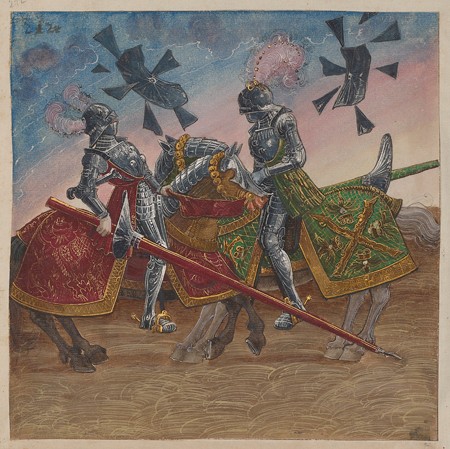One of the greatest patrons of the tournament was Emperor Maximilian I (1459–1519). For Maximilian the tournament was more than a sport for the elite; it was an important element in the web of power relationships that bound the imperial court and empire. The emperor himself took part in tournaments with nobility from all parts of his sphere of influence. The power relationships that he established through these events were of decisive political importance. Furthermore, Maximilian took a personal interest in the technical development of tournament armor and endeavored to enhance the tournaments he staged with the addition of spectacular effects.
Tournament books document in detail—and often in sumptuously illustrated form—sequences of tournaments hosted by courts and aspiring merchant cities. Among those who commissioned tournament books are René d’Anjou (1409–1480), the electors of Saxony, and especially the rulers of the Holy Roman Empire, to name only a few. These books bear witness to the culture of late medieval and Renaissance jousting. The Kunsthistorisches Museum in Vienna owns one of the most important of all tournament books: known as Freydal, it was made for Emperor Maximilian I in Germany in 1512–1515. It consists of 255 (originally 256) colored and richly gilded and silvered drawings that depict 64 tournaments. Each of the tournaments comprises a Rennen (joust of war), a Stechen (joust of peace), and
The National Gallery of Art owns an almost unknown yet highly significant manuscript that is closely related to the Viennese Freydal. It appears to represent an early draft of this tournament book and features annotations, most probably by the emperor himself, that in many cases include proposed compositional alterations implemented in the Viennese illustrations. The Washington manuscript consists of 203 colored drawings. Campbell Dodgson briefly examined this collection of drawings when they first appeared on the art market in the 1920s. He recognized the connection to the Viennese Freydal, which he knew from the annotated facsimile of the latter by Quirin von Leitner, dating from the 1880s. Despite their importance the drawings were not well known and remained unstudied for a long time, leaving many unanswered questions about them and their relationship to the Freydal in Vienna.
Von Leitner’s facsimile is still the most comprehensive study and remains in many respects a valuable source. Nevertheless, the work deserves new investigation and publication, particularly with regard to its genesis. My stay at CASVA offered a unique possibility to study the Washington manuscript. It belonged to an unknown French noble family in the late eighteenth and early nineteenth centuries, and in the mid-nineteenth
This research is an important step in the project on Freydal, which will result in a new and comprehensive publication. This book will include essays by various scholars, each focusing on a part of the compelling story of Freydal.
